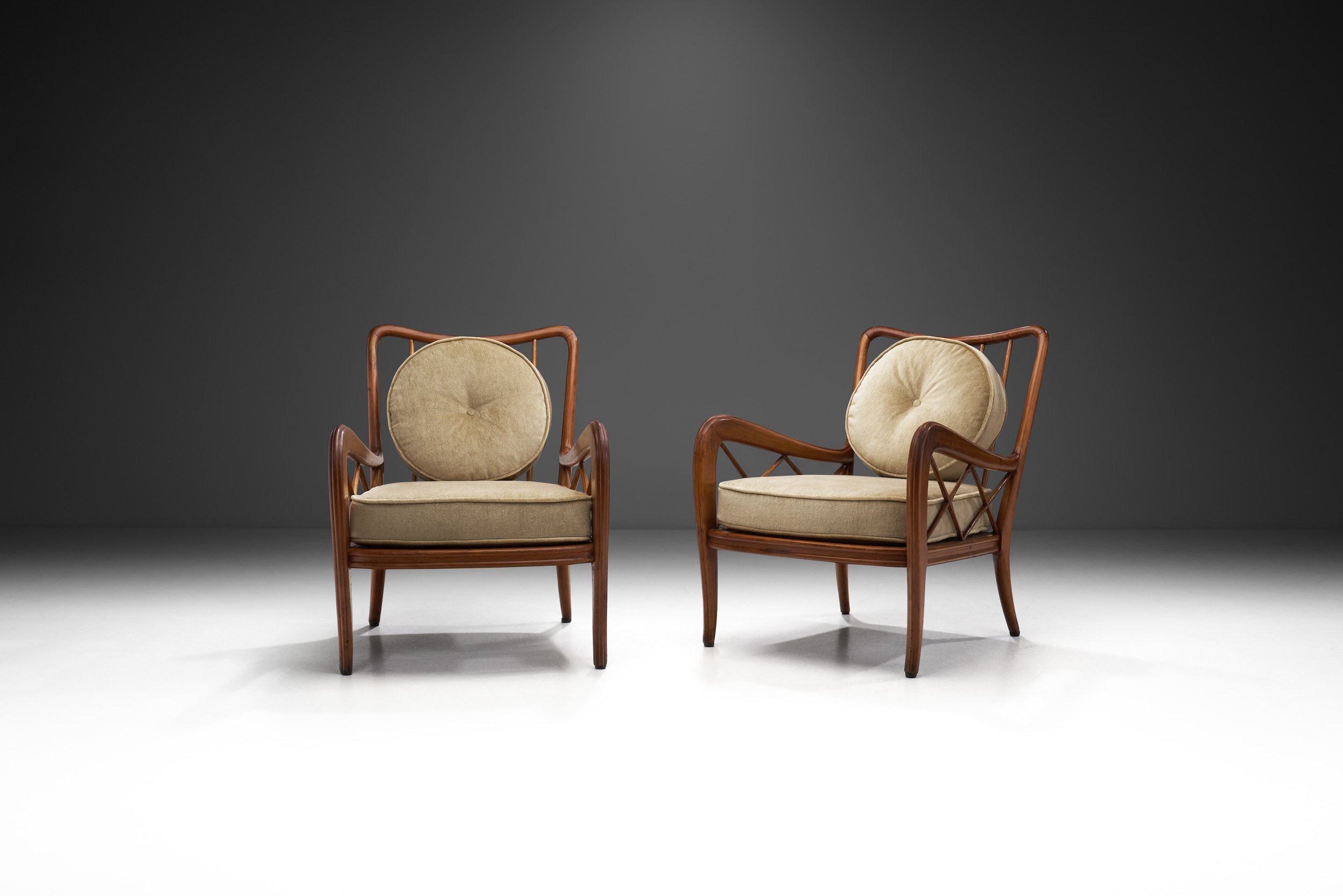Italian Modern Lounge Chairs with Upholstered Cushions Attributed to Paolo Buffa, Italy 1940s (sold)
















Italian Modern Lounge Chairs with Upholstered Cushions Attributed to Paolo Buffa, Italy 1940s (sold)
Italian Modern furniture is defined by unique design, perfect execution, and exclusivity. This pair of lounge chairs, attributed to Italian design icon Paolo Buffa, are a true testament to the glory days of mid-century modernism in Italy. His design language was always coherent with current times and congenial to the wisdom of furniture manufacturing, representing an outpost of strong innovation in the panorama of Italian craftsmanship.
This pair is focused on elegant and measured proportions, balanced compositions, and refined décor elements including the exclusive materials. The versatile shapes, from the curved, rounded edges on the top to the crossed panels on the sides and tapered legs, make these chairs stand out. The slatted backs and two crosses on each side contrast cleverly with the otherwise flowing lines of the frames to create a distinctive visual effect. The front legs effortlessly flow to form the armrests, creating a structured, sculptural impression. The design is especially successful at balancing its elegance with functionality while playing with geometry and different materials. The solid wooden frames are enriched with upholstered seat and back cushions in an elegant light velour fabric. Similarly to the versatility of the chairs’ structure, the cushions also have diversity in terms of shapes; the thick seat cushions are paired with round back pillows that showcase the slats on the back, enhancing the airy aesthetic. These lounge chairs have an artistic impression thanks to the dynamic look created by the contrast between the geometric and the flowing lines, while retaining the elegance inherent in Italian design.
Paolo Buffa was especially passionate about furniture and product design, an area where he remained faithful to a figurative repertoire of substantial classicism, while not disdaining impulses of authentic modernity. He was extremely active in the Milanese design scene that was just as vibrant as these lounge chairs. In an atmosphere committed to the reinterpretation of the Lombard classicism and Milanese architecture, exceptional pieces were created, exemplified by this pair.
SOLD
Condition:
In good vintage condition. Wear consistent with age and use. Small scratches and marks on the wood. The seat and back cushions are newly made and are upholstered in a premium velour fabric. Each of our items can be re-upholstered by our in-house atelier in a fabric of choice. Please reach out for more information.
Dimensions:
Chair 1
24.6 in W x 32.08 in D x 30.9 in H; Seat height 15.94; Arm height 22.63 in
62.5 cm W x 81.5 cm D x 78.5 cm H; Seat height 40.5 cm; Arm height 57.5 cm
Chair 2
24.8 in W x 31.69 in D x 30.7 in H; Seat height 16.14; Arm height 22.44 in
63 cm W x 80.5 cm D x 78 cm H; Seat height 41 cm; Arm height 57 cm
About the designer:
Paolo Buffa (born 1903, Milan – died 1970, Milan) was an Italian furniture designer who defined his own unique design aesthetic to become one of the most sought-after Italian designers of his day. Renowned for pairing elements from both the opulent Neoclassical and the streamlined Art Deco styles around a more modern sensitivity, Buffa excelled in creating high quality pieces that spoke to the well-to-do clientele of the time.
Born in Milan in 1903, Buffa trained at the Politecnico di Milano. Following his graduation in 1927, he worked briefly for Gio Ponti, and in 1928, he partnered with architect Antonio Cassi to establish their own design studio in Milan. By 1936, Paolo Buffa opened his own independent studio where he became particularly successful, in part because he had already tapped into his unique combination of stylistic elements. His incorporation of more traditionally Neoclassical motifs or materials – for example, rich rosewoods or supple, velveteen fabrics – with the relatively avant-garde forms and themes of a lighter Art Deco style made his pieces particularly attractive to the upper classes who wished to convey their connection with contemporary design trends while also upholding an air of old-world flair.
By the end of World War II, as was the case with other important Milanese designers of the time, Paolo Buffa built close collaborations with Lombardy’s craftsmen with the common objective of making furniture of exceptional quality at a larger scale. As such, many of the successful furniture pieces that Buffa designed during this time were made by prominent and entrepreneurial craftsmen that adopted more efficient production techniques. As his career progressed in the 1950s and 60s, Buffa experimented with designs that echoed the rising trends of Minimalism across the art and design fields. Some of the opulence that once dominated his creations was replaced with increasingly streamlined forms and modern materials.
Buffa continued to create designs until shortly before his death in 1970. By that time, he was recognized as one of Italy’s most accomplished designers, however for some time following his death his work and his legacy fell temporarily into relative obscurity. But over the last decade, recognition of his talents has resurfaced and Buffa’s work has returned to the place of prominence among twentieth-century Italian design masters. ~H.


















